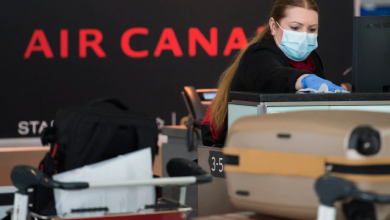Low-cost airlines and why they keep missing the boarding call in Canada
Lucas Wagner admits he’s not the most die-hard Blue Jays fan out there, but he’ll fly from Edmonton to Toronto to catch the baseball team’s home opener in late March to help maximize his purchase of Flair Airlines’ three-month unlimited travel pass.
“I probably wouldn’t have booked the flight myself if I hadn’t had this unlimited pass,” Wagner told CBC Radio’s Cost of Living.
“Now that there’s this unlimited pass I’m like, ‘Yeah, there’s more of Canada I want to explore,'” he said, adding he’s also considering a weekend trip to Vancouver.
For $700, pass holders can book as many domestic flights as they’d like with the airline between Feb. 13 and May 13, with no blackout dates.
It’s all about ‘stimulating’ the market
The deal appealed to Wagner, who said he wouldn’t have planned a trip to Toronto otherwise.
In that sense, Wagner is the ideal target customer for ultra low-cost carriers like Flair. In the industry, it’s called “stimulating the market,” according to aviation consultant John Korenic.
“It isn’t a matter of taking share away from Air Canada or WestJet, rather what it does is stimulating the market,” said Korenic, who also teaches at the University of British Columbia’s Sauder School of Business.
“Maybe they’ll go once or two more times during the year whereas if the fares were somewhat higher, maybe they’ll just go home at Christmas,” he said.
“Their main focus was to stimulate the market, [to attract] people who would drive or maybe people who would take the bus, growing the market or taking passengers from other modes of travel,” said Korenic.
It takes money for a fare deal in Canada
Anyone who’s shopped around for flights in the U.S. or Europe knows, low-cost options are abundant in those markets.
So why doesn’t Canada have its own array of airlines such as Ryanair, Frontier, Spirit or easyJet?
The simple answer is money.
The runway to low-cost flights in Canada is paved with steep financial losses: Zoom, Canada 3000, Jetsgo, Zip, Tango and WOW Air have all tried and failed.
“Starting up an airline is tough,” said Korenic. “The competition is tough and it’s to be expected so you’ve got to have deep enough pockets.”
There’s an old joke in the aviation business: What’s the best way to make $1 million in the airline industry? Start with $10 million.
Still, Korenic and others believe there is sufficient Canadian demand to warrant at least one low-cost carrier as long as investment is available.
However, Canadian investors in general are often more risk-averse than American counterparts.
In order to make money, airplanes have to be in the air and flying 12 to 14 hours daily. That’s especially challenging with Canada’s vast geography and low population density.
The Competition Bureau launched an investigation the fall into whether WestJet and Swoop used predatory pricing to beat Flair on certain routes.
CBC






Redes Sociais - Comentários